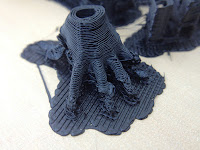The first piece is a marble sculpture by Cicero D'Avila. The torso and legs will prove an interesting challenge to reproduce, but the hands are not ideally placed for 3D printing because of the way the fingers are pointing down.
The second picture was a recent find which I think I can use to create the arm pose for my new design. I couldn't find information about the photographer - if you know, please pass the details on and I'll credit them.
Creating the pose wasn't too difficult and took me only a couple of hours. Project Miller is a fantastic new tool in my toolkit which hugely simplifies the process of making a 3D object printable. It can automatically wrap the model in a single manifold mesh which eliminates all of the problems with hair, eyes, teeth and folded limbs, at a single stroke.
I then took the raw model into Blender and began the process of sculpting in some additional details in the hair.
The next step was to find the best way of slicing and supporting the model ready for 3D printing. this time I decided to give Cura a try. Cura is an extremely fast slicer written by David Braam of Ultimaker. When I'm evaluating a sliced model that needs support, I look for the right amount of support material with an adequate gap between the support and the model so that it will break away with the minimum of effort.
My first attempt at printing this model, which I have named Cicero for convenience, used a light grey PLA and took over 8 hours to print. The lower half started well but sadly the head and arms are not as smooth and seem covered in a regular indentation. The pose looks great though and is definitely one I would consider using again.
The next step was to find the best way of slicing and supporting the model ready for 3D printing. this time I decided to give Cura a try. Cura is an extremely fast slicer written by David Braam of Ultimaker. When I'm evaluating a sliced model that needs support, I look for the right amount of support material with an adequate gap between the support and the model so that it will break away with the minimum of effort.
My first attempt at printing this model, which I have named Cicero for convenience, used a light grey PLA and took over 8 hours to print. The lower half started well but sadly the head and arms are not as smooth and seem covered in a regular indentation. The pose looks great though and is definitely one I would consider using again.




































